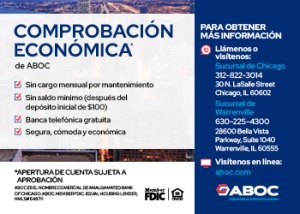Latest
-
 Senator Dick Durbin Not Seeking Re-Election April 24, 2025
Senator Dick Durbin Not Seeking Re-Election April 24, 2025 -

-

-

-

Popular
Tags
Artistas Adolescentes Aprenden el Valor de un Arduo Trabajo
Artists Nationwide
Brazilian Students Tour Kirie Water Reclamation Plant
Challenges of Returning to School in Adulthood
Chicago
Chicago Air and Water Show
Chicago CPS
Chicago Dream Act
Comparta su Historia
CPS
Cultura Latina
Delicious Salad Meals
Dream Act
Dream Act chicago
Dream Relief
Dream Relief Chicago
El Alma de la Fiesta
Ending Summer on the Right Foot
Ensaladas sencillas y deliciosas como plato principal
Estudiantes Brasileños Recorren la Planta de Reclamación de Agua Kirie
Feria de Regreso a la Escuela de la Rep. Berrios
Festival Unísono en Pilsen
Grant Park Spirit of Music Garden
ICIRR
ICIRR Receives Criticism Over Dream Relief Day
ICIRR Recibe Críticas
Jose Cuervo Tradicional
José Cuervo
José Cuervo Tradicional Celebra la Cultura Latina e Inspira Artistas a Nivel Nacional
Latin Culture
Los Retos de Volver a la Escuela Cuando Adultos
Meijer Abre sus Puertas en el Distrito de Berwyn
Meijer Opens in Berwyn District
orth side Summer Fest on Lincoln Ave
PepsiCo Foundation Apoya Futuros Periodistas Hispanos
PepsiCo Foundation Supports Future Hispanic Journalists
Share Your Story
Show Acuático y Aéreo
Simple
StoryCorps
storycorps.org
Teen Artists Learn the Value of Hard Work
Terminando el Verano con el Pie Derecho
Unisono Festival in Pilsen
‘El Chente’





The Great New York Tragedy Before 9/11
By: Daniel Nardini
Prior to the fire, factory sweatshops were an everyday reality in the American industrial landscape. In these type of factories, workers were forced to labor in over-crowded rooms, ventilation was poor, and there were no enforced safety standards. Such conditions existed in almost all sweatshop factories, and the factory owned by the Triangle Waist Company was no exception. The Triangle Waist Company manufactured primarily women’s clothing. It would be in this factory that a fire was accidentally started on March 25, 1911.
Due to poor ventilation the fire spread quickly. Many of the workers could not get out of the building—most emergency exit doors were locked or blocked, the emergency window ladders failed to work, the stairways were too narrow, and worse there was no sprinkler system nor equipment to fight the fire. The fire eventually engulfed the whole building. Many workers jumped out of the windows to their deaths to escape the fire. In the end 146, mostly women, were killed in the fire.
This tragedy had far-reaching consequences. The ranks of unions swelled, and unions began to fight for stricter safety standards. Even local political officials in New York City started to work for a stricter code of fire prevention. The legislation that was passed in New York City became a model for other major cities—more than one stairway leading out of a building, emergency exits that had to remain clear 24 hours a day, sprinkler systems that worked, and vastly improved ventilation systems. Moreover laws were enacted to hold factory owners accountable for their actions.
What happened in 1911 marked the beginning of how factory working conditions in the United States and especially worker safety vastly improved from what it was. That tragedy has helped to change the working environment we are employed in today. More than that, the laws passed since make those employers who break these laws more accountable for their actions. Just as September 11th has changed how Americans view security today, the Triangle Waist factory fire has changed our working environment.